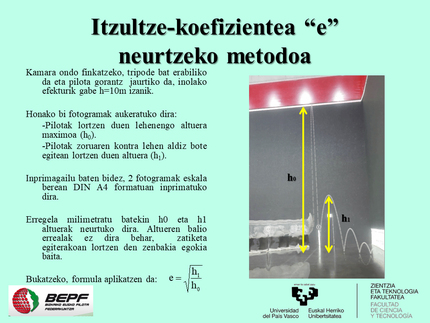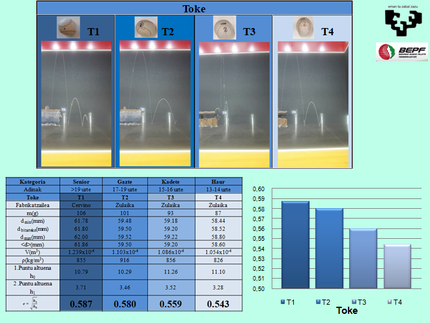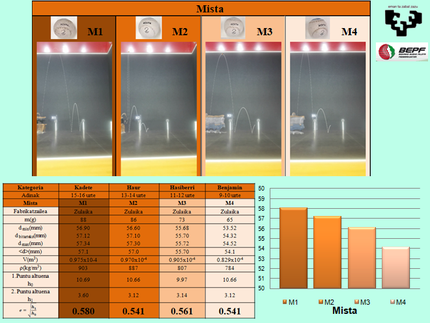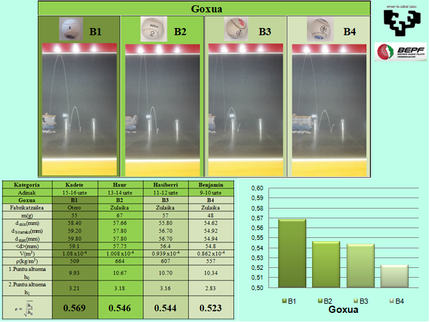Measuring the pot of hand balls
Each federation establishes in its regulations the tests that must overcome the balls. These tests are performed by professional balls that decide which balls are useful. To facilitate the work of the pelotaris and have objective information about the ball boats, it would be beneficial to establish a method.
This article presents the results of a research carried out in an end of degree work. The work was presented at the Faculty of Science and Technology of the UPV/EHU and was carried out in collaboration with the Bizkaina Federation of Basque Ball (FGV) [1,2]. All the experiments have been carried out on the Miribilla pediment[4]; with the collaboration of professional pelotaris, the balls have been thrown without any effect, as is done in the validation tests. The objective of the work has been to perform an experiment to quantitatively differentiate 12 types of hand ball.
Balls used in Basque ball
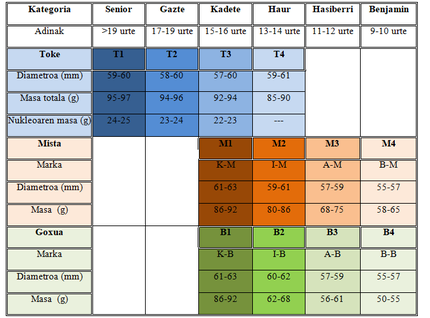
In the Basque ball, and specifically in the hand, the ball is the main element and its characteristics are the diameter, the mass and the entire diameter of the core (data that usually appear in the regulations of materials). The pelotari, depending on the force you exert when throwing the ball, will use one or another type of ball. Depending on this, three groups are distinguished: sweet, mixed or half-point and toke. One of the softest balls is sweet, it does not emit large boats and, above all, it is used by children. Tokekoa, meanwhile, is a ball used by professionals that manufactures high altitude boats. Between the two, finally, we have the mixed or half-point. For each of them the age levels are established, from benjamin to senior. Thus, balls can be 12 types, depending on the size of the core (group) and the age of the balls.
The balls are still manufactured by hand [5]. They have a rubber core, around which the linings of latex, wool and cotton are collected, to finish with the sewn of the goat leather. The pot of the ball depends on its core. This core is denser than the materials that make up the coatings. Therefore, changing the percentages of wool and cotton, you can get small balls, more useful for children.
Only the pelotaris know the size and composition of the core, you should break the ball to know how the core of the ball is. Pelotaris, although they use different techniques, know the requirements that the ball must meet to be of one level or another. Then, to ensure the quality of these balls and to know if it meets the characteristics of the corresponding set, a professional pelotari analyzes their behavior making ineffective shots on a pediment.
How to differentiate token balls from sweet balls?
In principle, if a ball is thrown at something that is hard, like marble, the toke ball sounds like a shot: “Danba!” The sweet, on the other hand, will cause a weaker sound: “Zapel!” The balls must be pulled hard. However, this method is not scientific and therefore we have designed an experiment to differentiate the balls.
Return coefficient, e
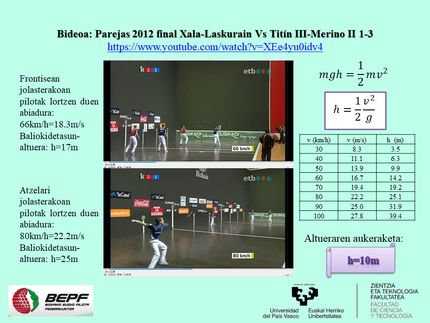
The pot of a ball is measured: suppose that we have a ball and that we release the h0 of a certain height without effect; when we throw it against the ground, the h1 will reach the maximum height; then it will again throw it against the ground, and so it will continue until it stops. The return coefficient is defined as e ={(h1/h0). As the ball loses energy when bouncing, the height h1 will never be greater than h0, so it will always be less than 1.
To check if the differences between the balls are revealed through the experiment, it has been decided to perform the test with two balls of opposite characteristics: the senior ball, the fastest ball available, and the sweetest cadet ball, one of the slower. In the experiments carried out, the height h0 had several values (0.5 m, 1 m, 2 m and 3 m), no differences had been obtained for the value of e. In all cases, for both balls an approximate value of 0.65 is obtained.
Why does that happen? When the ball goes slowly, the two balls, those of senior touch and the cadet guts, play as a very elastic object, that is to say, when you throw hardly lose energy and the value of e is very high. When speeds increase, differences begin to be noticed, being able to distinguish between high (high) and low (low) balls. In order to achieve the speed that the balls give to the ball in the ball matches, it has been determined that the pitch height of the balls in the experiments is h0 = 10 m.
The study was carried out using the “measure Dynamics” software. This allows obtaining the position, speed and acceleration of the ball. In addition, you can scale objects to get their real value, as well as strobe images of balls shots. We want to thank the Federation of Basque Ball, specifically Iker Gardoki and Endika Basañez, pelotari and those responsible for the local sports promotion [2,9], who have carried out experiments on the pediment of Miribilla [4].
As a result of the study, a method of measurement has been proposed and does not require knowledge of physics or software. In the method it is proposed to record the video and select by a computer the two frames corresponding to the heights h0 and h1. The choice of these frames is very simple, since at maximum heights the ball is practically stagnant. In addition, with this method it is not necessary to scale because it is a division between heights and with this operation the units are simplified.
The study of the 12 hand balls has been divided according to the three types of balls, the playing, the mixed and the sweet, since the diameters of their cores are different. The results show a higher to lower return coefficient of the pelotaris for each type of ball. These results should be independent of the manufacturer and the situation of each ball. However, significant differences have been found in the value of e for each ball, since the ball can throw in the smooth part of the coverage or in the seam, which is not controllable. To compensate for this asymmetry 5 shots have been made with each ball, calculating its average value.
In addition, as they are used, the seams of the balls are treading, the outer coating gives it and the compactness of the ball changes. Another important factor is the temperature of the ball, since it emits different according to the values of the dilation coefficient of the materials that compose it. Much remains to be done, as experiments have been conducted at room temperature. It would be very interesting to analyze how the value of e changes with temperature.
Note: the table of each figure shows the name of the manufacturer of the balls, the total mass m, the measurement of the three diameters (dmin, dmedio, dmax) and the value of the average diameter <d>. Measurements have been made with caliber (accuracy ± 0.02 mm) and balance (accuracy ± 1 g). This data has calculated the volume V and the density ñ of the balls. Finally, the e value of each ball is shown. In addition, there is a strobe image of the releases and a graph with the results of e.
Bibliography
[1] S.R. Gutierrez-Solana, Characterization of the balls of the balls used in the sport of Basque Ball “handball” using the software “measure Dynamics,” Director I. Ruiz-Larrea. • Degree in Physics. UPV/EHU, 2017.
[2] Federation of Basque Ball/Federation of Basque Ball, http://www.bizkaiapilota.com/es/
[3] Phywe excellence in science, measure Dynamics: Automatic Motion Video Analysis, http://www.phywe-es.com/1054n532/Services/Downloads/Software.
[4] Frontón and Kirol Etxea de Miribilla | Bilbao International, http://www.bilbaointernational.com/fronton-y-kirol etxea-de-miribilla/
[5] Hand balls - KIROLAK BAT, http://www.kirolakbat.com/15-hand balls
[6] Restitution coefficient, Wikipedia Encicl. Free. (2017). https://es.wikipedia.org/w/index.php?title=coefficient_de_restituci%C3%B3&oldid=98632655
[7] Ángel Franco García, Computer physics. •
[8] Basque Ball School Tournament 2014-2015, Basque Ball Federation/Euskadiko Pilota Federazioa, 2014.
[9] Federation of Basque Ball/Federation of Basque Ball, Federation Structure - Federation of Basque Ball, http://www.bizkaiapilota.com/es/federacion/structure-de-la-federacion.



